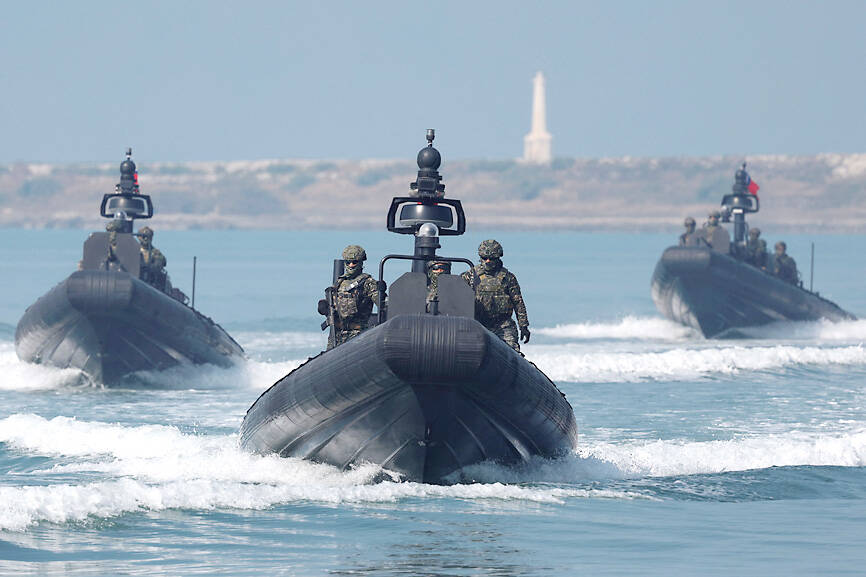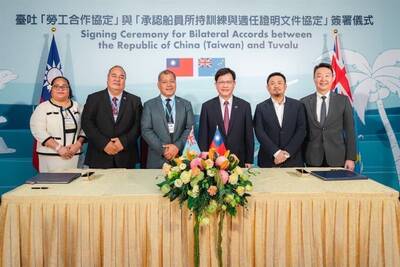Three of Taiwan’s field army commands this month would each hold anti-landing drills on a beach in their jurisdiction, including two public beaches, the Fisheries Agency said in three notifications on May 23 and Monday last week.
The first drill would be held on Wednesday by the army’s Tainan-based Eighth Army Corps on a public beach in the Sishu Coastal Recreation Area, the agency said.
The Sixth Army Corps on June 18 would be training on Jhongfu Beach (中福海灘) in New Taipei City, while the 10th Army Corps would conduct a live-fire drill on June 26 at Taichung’s Caocuosi Beach (草厝溪海灘), the agency said.

Photo: Carlos Garcia Rawlins, Reuters
The military has been strengthening its defense protocols with weapons practices, wargames and live-fire drills conducted on the nation’s “red beaches.”
Beaches in Taiwan are categorized into three color codes: Red beaches could see large-scale landing operations and are the most vulnerable to a Chinese People’s Liberation Army invasion; yellow zones are beaches that could see unconventional landing operations; and blue beaches are locations that would be difficult to invade.
Anti-landing drills that involve shooting practices on beaches aim to familiarize soldiers with the environment of a potential battlefield, the military said.
Firing rounds on beaches differs from target practice in controlled environments, as environmental factors such as wind and sand can affect visibility and the functionality of weapons, the military said.
The military also increased the number of anti-landing drills on red beaches, such as in Tainan’s Sishu Coastal Recreation Area.
Because these areas are accessible to the public, the army had only conducted basic drills such as physical training and hardware construction before the first live-fire exercise in Taoyuan’s Guanyin Coastal Recreation Area, which was held at the end of last year.
The three red beaches selected for the anti-landing drills this month were also evaluated by analyst Ian M. Easton in his book The Chinese Invasion Threat: Taiwan’s Defense and American Strategy in Asia for their tactical relevance.
Sishu (喜樹) could be a target due to its closeness to important locations such as Taoyuan International Airport and Tainan Air Base, and infrastructure such as the Coastal Highway, Easton said.
Jhongfu Beach was mentioned for its proximity to Taoyuan International Airport and Linkou Power Plant, as well as Caocuosi Beach, as it is near Taichung International Airport, which is also an air base.

The Ministry of Economic Affairs has fined Taobao NT$1.2 million (US$36,912) for advertisements that exceed its approved business scope, requiring the Chinese e-commerce platform to make corrections in the first half of this year or its license may be revoked. Lawmakers have called for stricter enforcement of Chinese e-commerce platforms and measures to prevent China from laundering its goods through Taiwan in response to US President Donald Trump’s heavy tariffs on China. The Legislative Yuan’s Finance Committee met today to discuss policies to prevent China from dumping goods in Taiwan, inviting government agencies to report. Democratic Progressive Party Legislator Kuo Kuo-wen (郭國文) said

The Ministry of Economic Affairs has fined Taobao NT$1.2 million (US$36,900) for advertisements that exceeded its approved business scope and ordered the Chinese e-commerce platform to make corrections in the first half of this year or its license would be revoked. Lawmakers have called for stricter supervision of Chinese e-commerce platforms and more stringent measures to prevent China from laundering its goods through Taiwan as US President Donald Trump’s administration cracks down on origin laundering. The legislature’s Finance Committee yesterday met to discuss policies to prevent China from dumping goods in Taiwan, inviting government agencies to report on the matter. Democratic Progressive Party

Taiwan and its Pacific ally Tuvalu on Tuesday signed two accords aimed at facilitating bilateral cooperation on labor affairs, according to Taiwan’s Ministry of Foreign Affairs (MOFA). The governments inked two agreements in Taipei, witnessed by Foreign Minister Lin Chia-lung (林佳龍) and visiting Deputy Tuvaluan Prime Minister Panapasi Nelesone, MOFA said in a news release. According to MOFA, the agreements will facilitate cooperation on labor issues and allow the two sides to mutually recognize seafarers’ certificates and related training. Taiwan would also continue to collaborate with Tuvalu across various fields to promote economic prosperity as well as the well-being of their

Sung Chien-liang (宋建樑), who led efforts to recall Democratic Progressive Party (DPP) Legislator Lee Kun-cheng (李坤城), was released on bail of NT$80,000 today amid outcry over his decision to wear a Nazi armband to questioning the night before. Sung arrived at the New Taipei District Prosecutors’ Office for questioning in a recall petition forgery case last night wearing a red armband bearing a swastika, carrying a copy of Adolf Hitler’s Mein Kampf and giving a Nazi salute. Sung left the building at 1:15am without the armband and covering the book with his coat. Lee said today that this is a serious